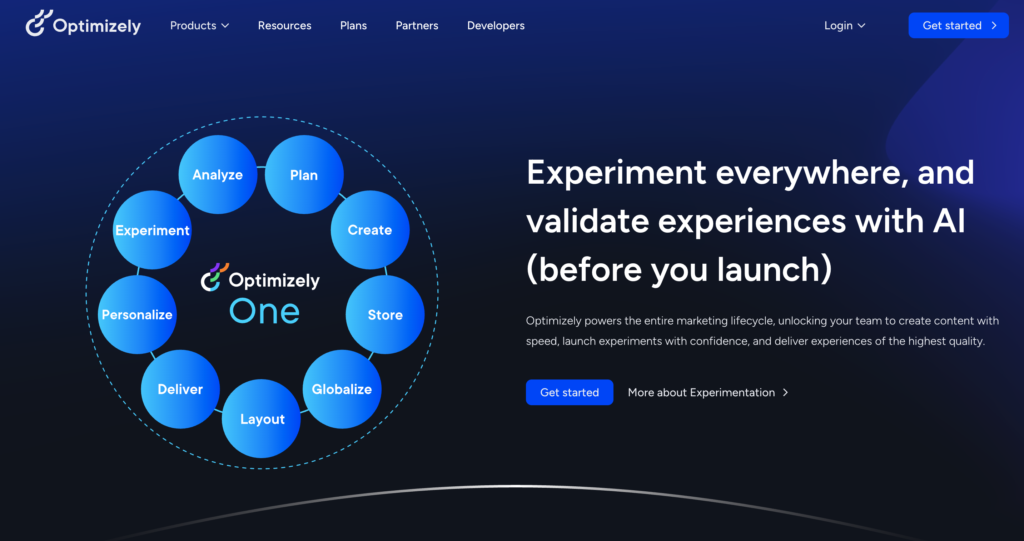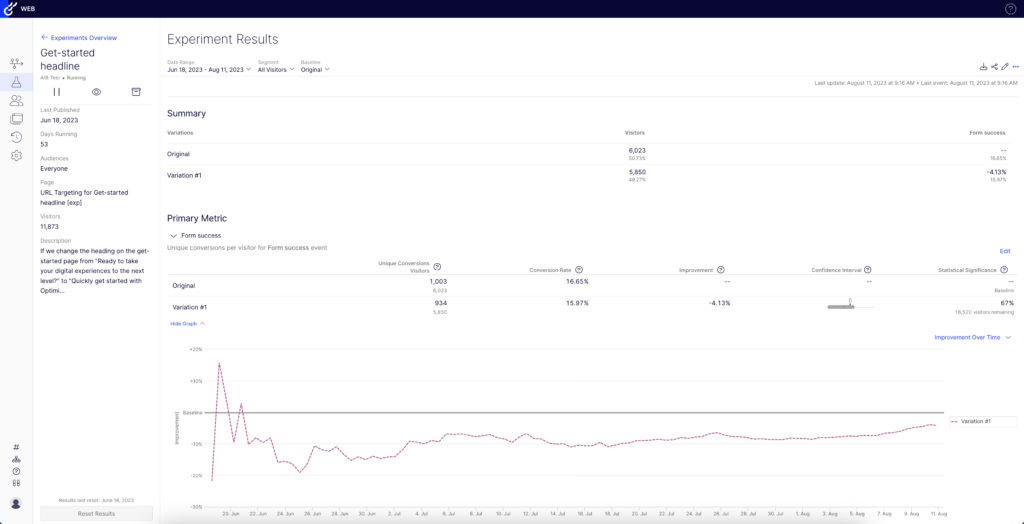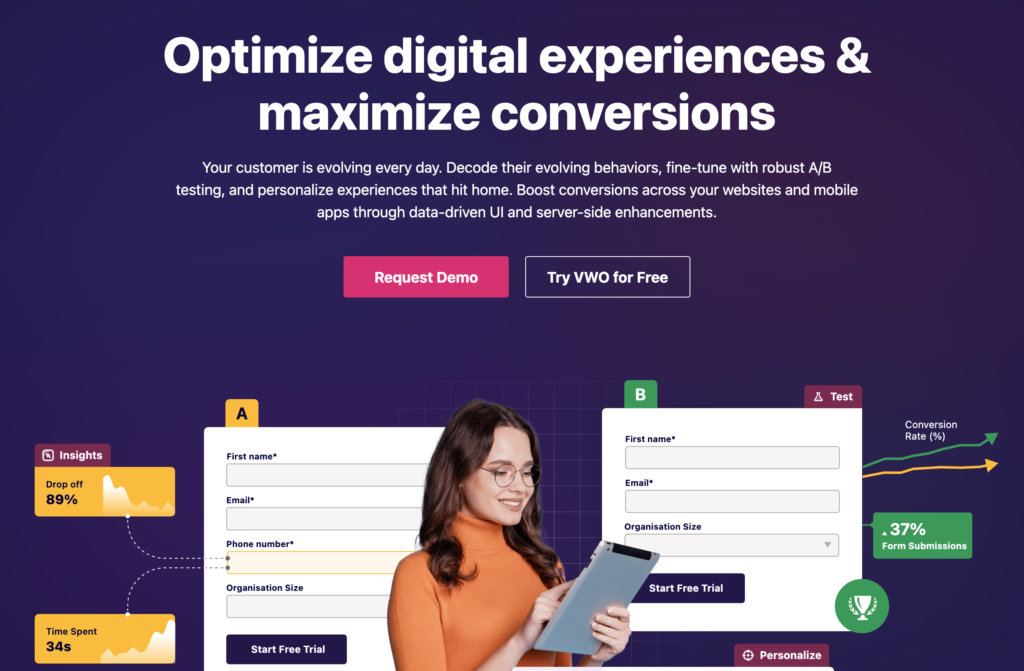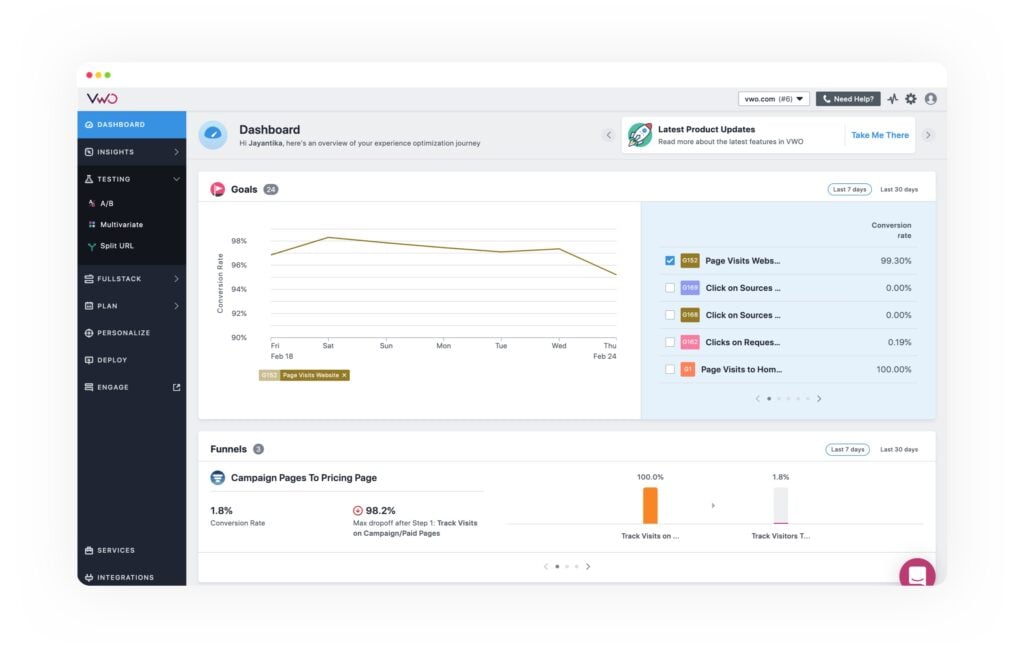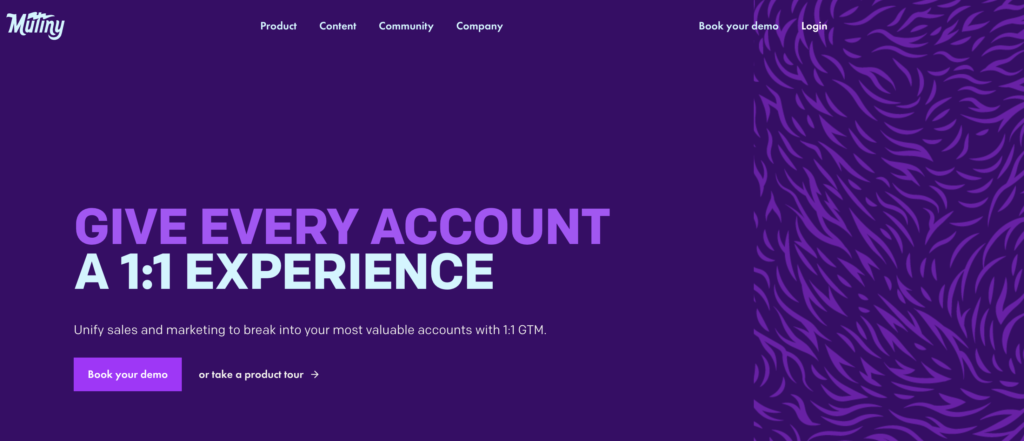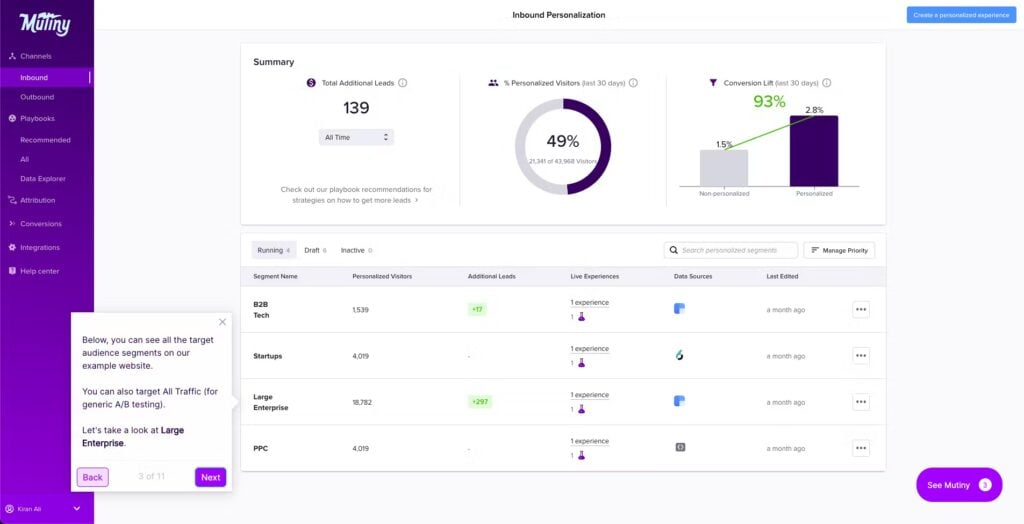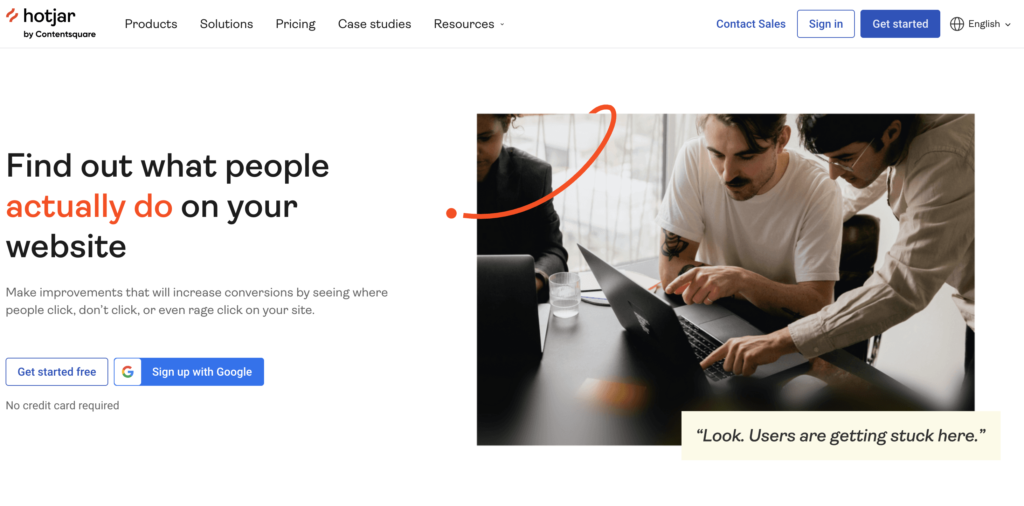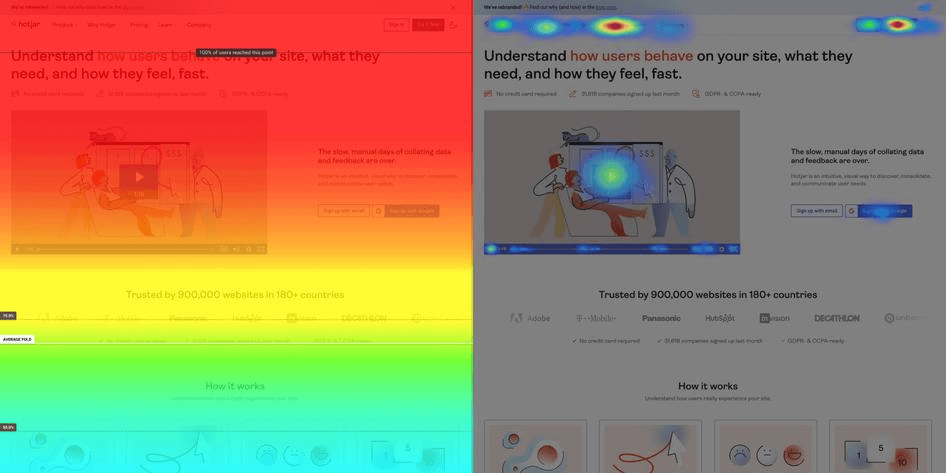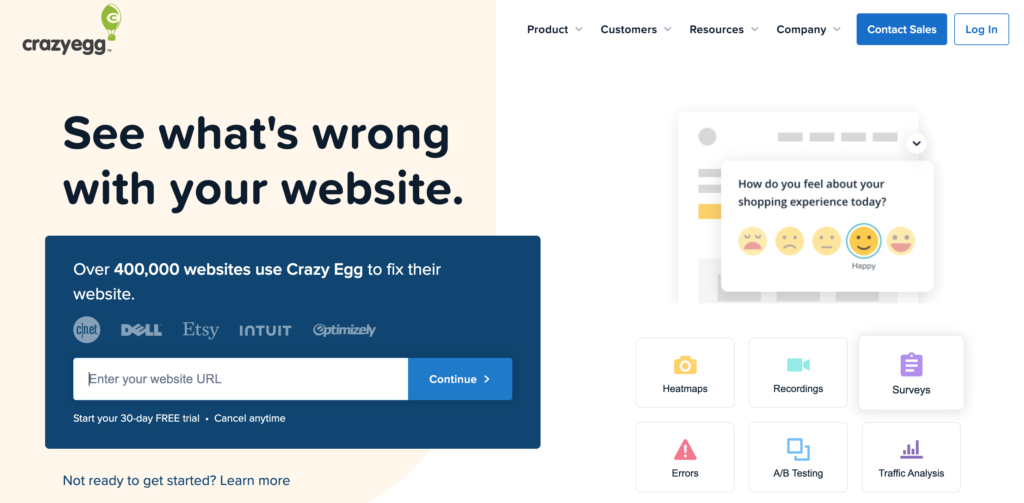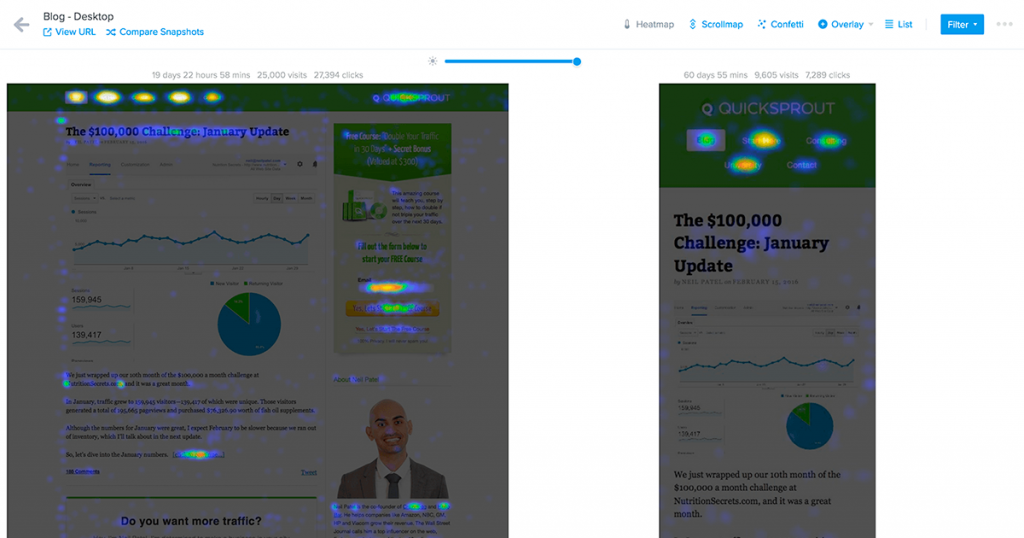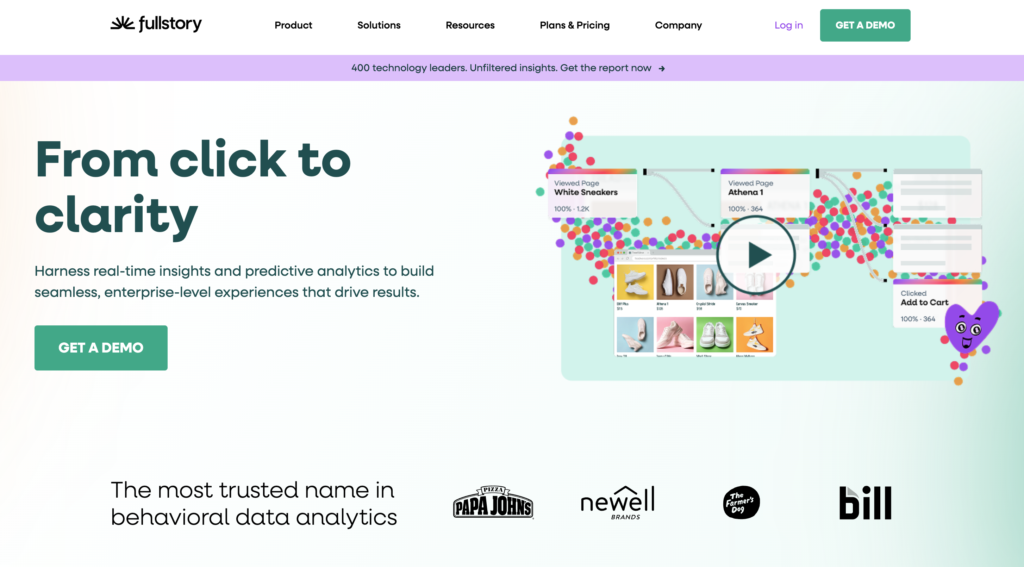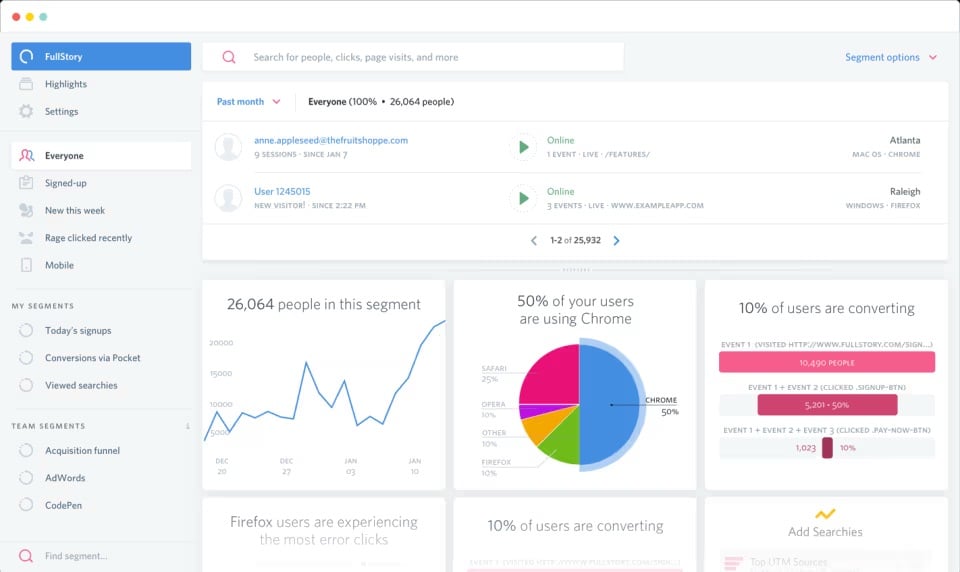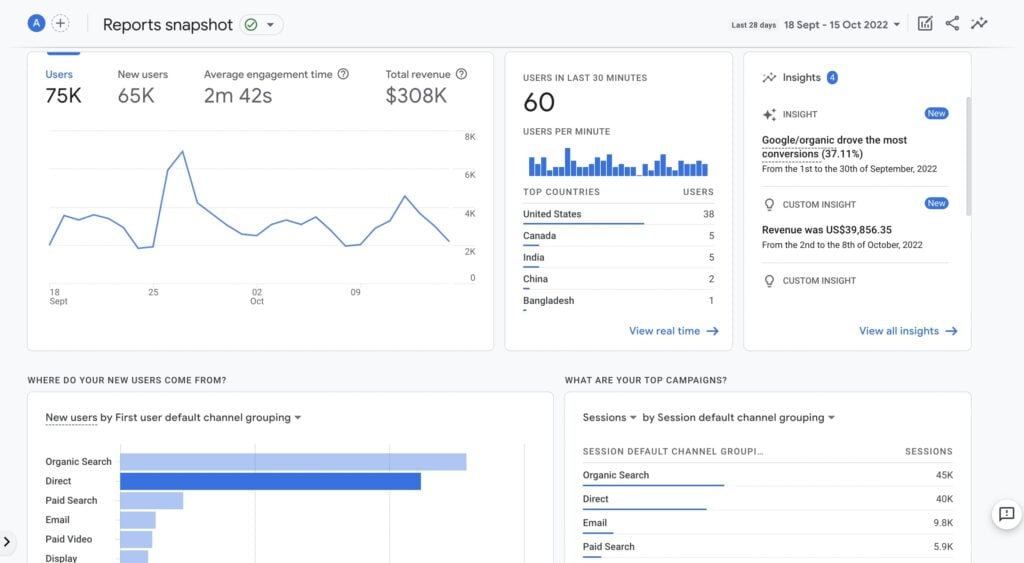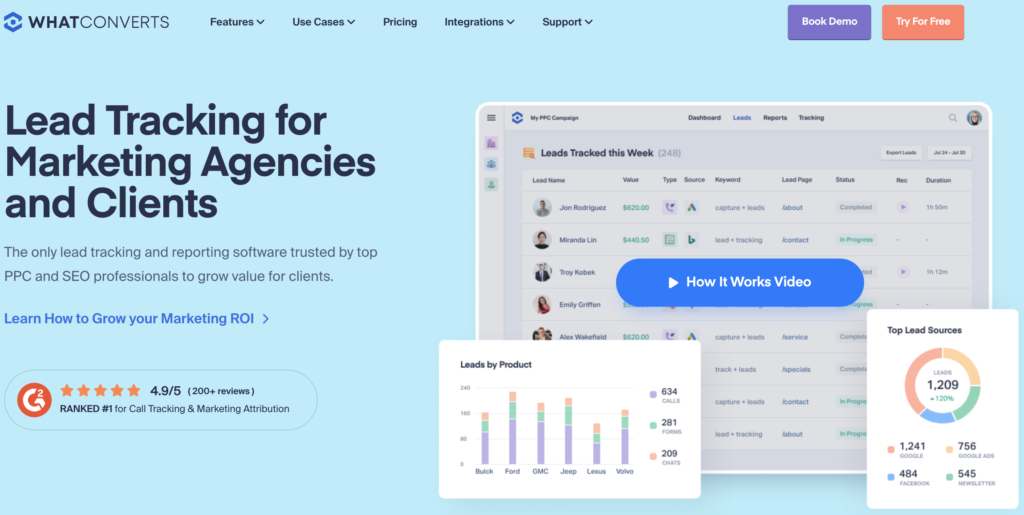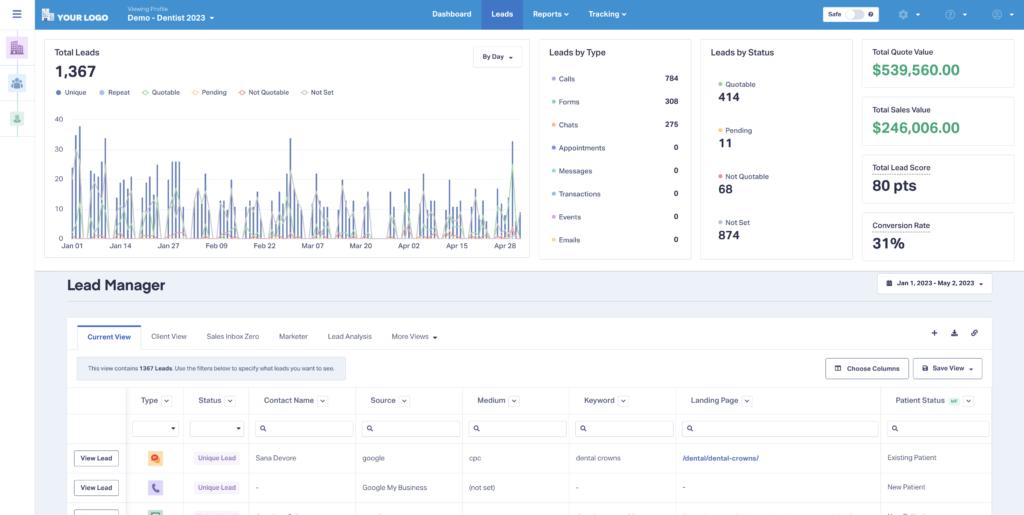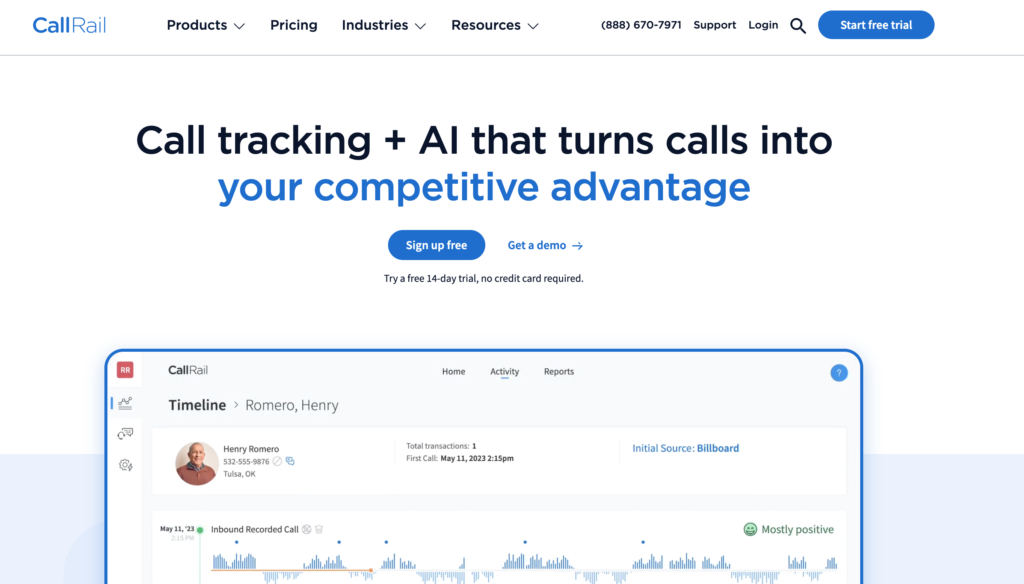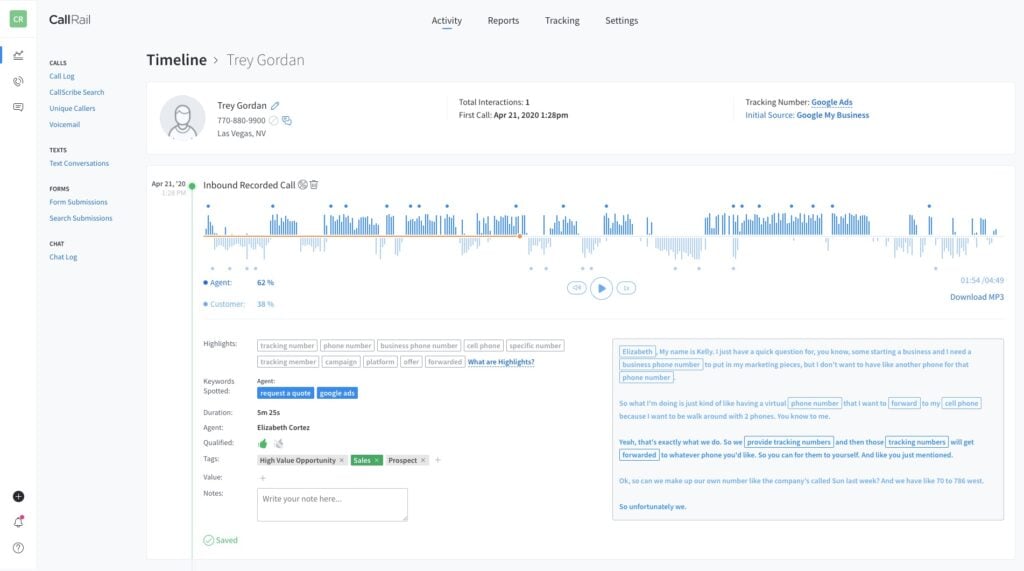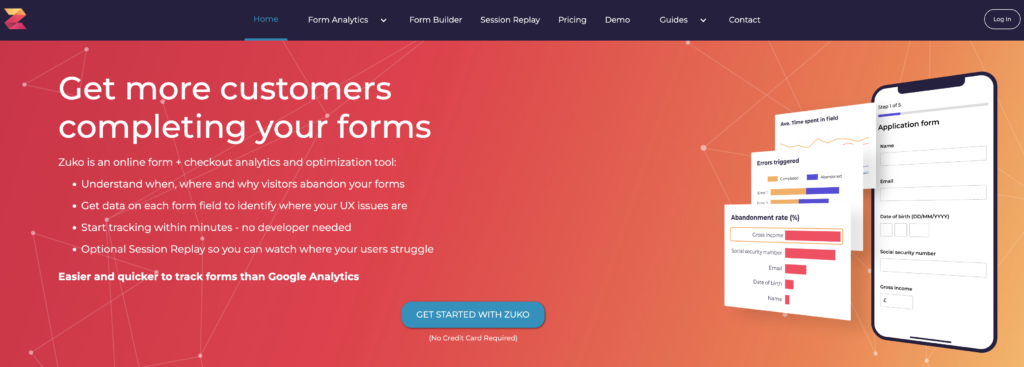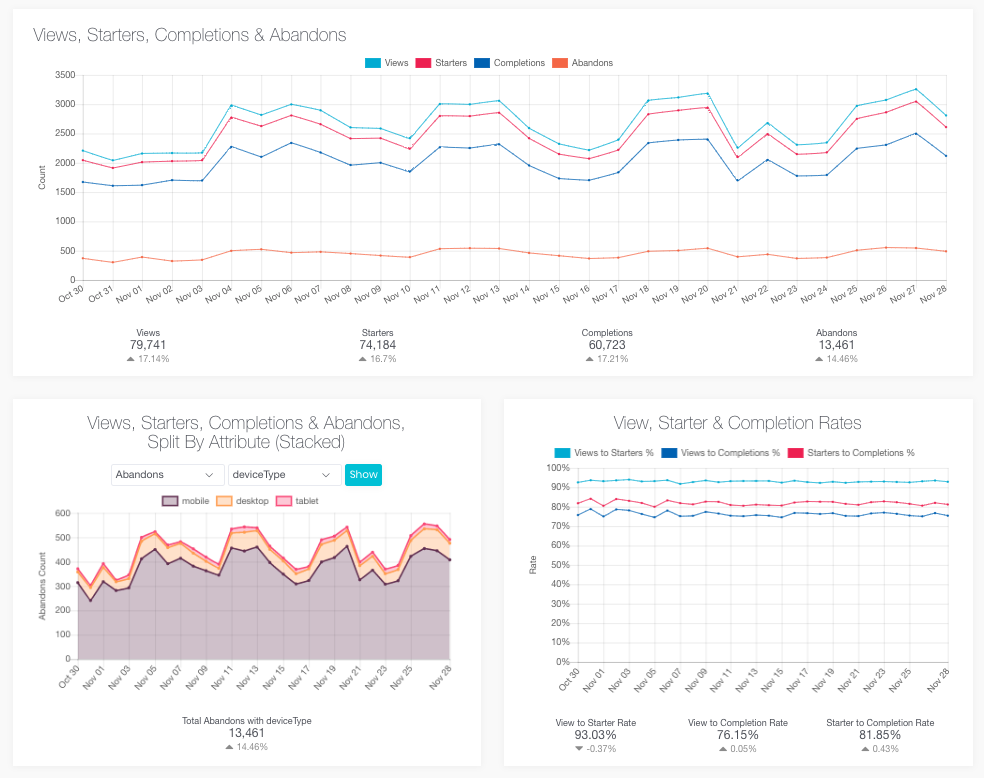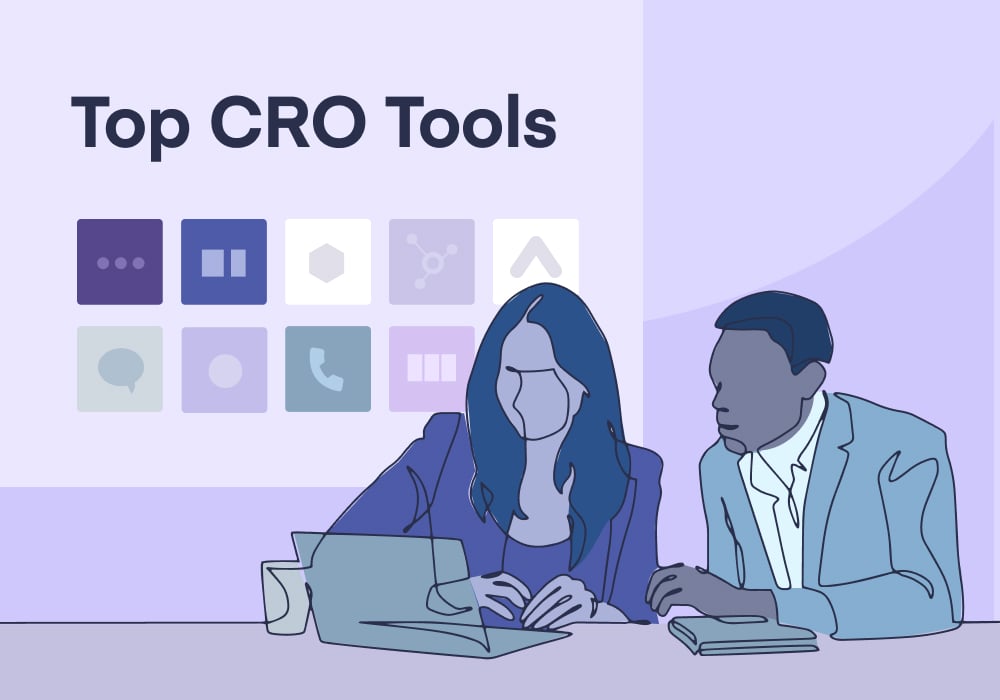
Conversion rate optimization often requires a stack of tools across different categories – from A/B testing platforms to heatmap and session replay tools, lead tracking solutions, form analytics, and personalization engines. Below we analyze some of the top CRO tools in each category, detailing their capabilities, ideal users, pros/cons, recent updates, and pricing.
To give a quick snapshot, the table below compares key aspects of these tools:
| Tool | Category | Free Plan | Starting Price (Paid) | Notable Strengths |
| Google Analytics (GA4) | Web Analytics / Conversion Tracking | Yes | Free (GA4 standard) | Industry standard analytics; funnels & goals |
| Hotjar | Heatmaps & Session Replay | Yes (basic) | $99/mo (20k sessions) | Heatmaps & recordings; VoC feedback; funnels |
| Crazy Egg | Heatmaps & A/B Testing | 30-day trial | $29/mo (5k views) | Click heatmaps (incl. “Confetti” view); simple A/B tests |
| FullStory | Session Replay & DX Analytics | Yes (1k sessions) | Contact for paid (usage-based) | Deep session insights; error & bug tracking |
| Optimizely | A/B Testing & Personalization | Trial (demo) | Custom (Enterprise-focused) | Enterprise experiments (web & feature flags); content delivery |
| VWO (Visual Website Optimizer) | A/B Testing & Behavior Analytics | Trial (free trial) | ~$99/mo (entry) | All-in-one testing + heatmaps & forms; SMB-friendly pricing |
| WhatConverts | Lead Tracking (Calls, Forms, & More) | 14-day trial | $30/mo (Call Tracking plan) | All-in-one lead attribution (calls, forms, chats); lead management; robust reporting |
| CallRail | Call & Form Tracking | 14-day trial | $45/mo (5 #s, 250 min) | Call tracking + forms |
| Zuko Analytics | Form Analytics & Optimization | Demo | ~$70/mo (Basic) | Field-by-field form drop-off analysis; won CRO tool award |
(Prices noted are as of 2024–2025 for lowest paid tiers; many tools offer higher-tier plans for enterprise needs. Free trials are common. Refer to each vendor’s site for up-to-date pricing.)
Below, we dive into each tool with an overview, key features, use cases, drawbacks, comparisons, recent updates, and pricing details.
Optimizely: A Comprehensive Experimentation Platform for Enterprises
Category: A/B Testing & Personalization Tools
Overview
Optimizely is a robust digital experience platform (DXP) designed for large-scale website and product experimentation. It excels in A/B testing, feature flagging, and AI-driven personalization across websites, mobile apps, and other digital channels. Following its merger with Episerver, Optimizely now includes content management (CMS) and e-commerce capabilities, making it a one-stop solution for enterprises.
Key Features
Optimizely offers powerful A/B and multivariate testing (client-side and server-side) with stats governance. Its feature experimentation allows gradual feature rollouts, and its AI-powered personalization engine targets content based on audience attributes. A visual editor enables non-technical users to create experiments, while advanced users can leverage SDKs and APIs for full-stack testing. Seamless integration with analytics tools further enhances its capabilities.
Use Cases
Optimizely is ideal for testing new product features (e.g., rolling out a beta feature to 10% of users), optimizing high-traffic e-commerce funnels, and personalizing content based on user behavior. Enterprises rely on Optimizely to validate website changes or feature updates through data-driven experimentation before full deployment.
Drawbacks
Optimizely’s complexity and cost make it less accessible for smaller businesses. Pricing is enterprise-level, often reaching tens of thousands of dollars annually. The learning curve can be steep, and advanced testing may require developer support. Some users find the interface overwhelming due to its extensive feature set.
Comparisons
- Optimizely vs. VWO: Optimizely is preferred by enterprises needing server-side testing and deep integrations, while VWO is more affordable and user-friendly for SMBs.
- Optimizely vs. Adobe Target: Optimizely is generally considered more agile and user-friendly, whereas Adobe Target also caters to advanced personalization but with a steeper learning curve.
- Optimizely vs. Google Optimize: With Google Optimize discontinued in 2023, many users shifted to Optimizely or GA4’s limited experiments.
Recent Updates
Optimizely continues expanding through acquisitions, integrating CMS and product recommendation features into its DXP. AI-powered automation, such as personalized content recommendations, keeps it competitive in the market.
Pricing
Optimizely does not publish pricing, requiring a custom quote. It is primarily targeted at large enterprises, with industry estimates suggesting high-five-figure annual costs. While Optimizely offers demos and occasional trials for qualified prospects, it lacks a free tier for ongoing use.
VWO: All-in-One CRO Platform for Testing & Behavior Analytics
Category: A/B Testing & Personalization Tools
Overview
VWO (Visual Website Optimizer) is a comprehensive conversion rate optimization (CRO) platform combining A/B testing, behavioral analytics, and personalization. It is well-suited for small-to-midsize businesses and agencies seeking multiple CRO capabilities in a single tool. Originally launched as a user-friendly A/B testing solution, VWO has expanded to include heatmaps, session recordings, form analytics, and push notifications.
Key Features
VWO offers visual A/B and multivariate testing with a WYSIWYG editor, allowing marketers to make changes without coding. It supports split URL testing for landing pages and includes qualitative tools like heatmaps, click maps, scroll maps, and session recordings to track user engagement. Form analytics help pinpoint drop-off points, while on-page surveys and feedback polls collect user input. VWO’s personalization module enables custom experiences for different visitor segments, such as returning users versus new visitors.
Use Cases
VWO is ideal for iterative website design improvements—e.g., A/B testing headlines or layouts using heatmap insights. E-commerce businesses test product page designs while monitoring recordings to identify drop-off causes. Lead generation marketers use form analytics to optimize signup forms, then run A/B tests on variations. VWO’s personalization allows businesses to tailor homepage content based on visitor type, improving engagement.
Drawbacks
While user-friendly, VWO’s interface can still be complex due to its extensive features. Some users report a flicker effect (original content briefly loading before test variations) if implementations aren’t optimized. External analytics integrations require setup, though Google Analytics is supported. Pricing is reasonable at entry levels but increases with traffic volume and additional modules.
Comparisons
- VWO vs. Optimizely: VWO is more cost-effective for client-side testing and includes qualitative tools (heatmaps, recordings) that Optimizely lacks natively. However, Optimizely offers more advanced developer-focused experimentation (feature flags, SDKs).
- VWO vs. AB Tasty: Both offer similar CRO tools, but VWO’s analytics tools are a strong advantage, while AB Tasty emphasizes AI-driven recommendations.
- VWO vs. Hotjar: VWO includes heatmaps and recordings like Hotjar but adds A/B testing, making it a more comprehensive optimization platform. Many teams use Hotjar alongside VWO for qualitative insights.
Recent Updates
VWO continues refining its platform, introducing a Plan module for managing experiment ideas and a Server-side testing option for developers. UX improvements have been made to the test editor and results dashboard. To align with privacy changes, VWO has integrated hypothesis tracking and Bayesian statistics for more reliable results. Pricing has also become modular, allowing customers to start with one product (e.g., VWO Testing) and add others (Insights, Personalize) as needed.
Pricing
VWO follows a tiered pricing model based on traffic and selected modules. Plans start around $99/month and scale up to $467/month for high-traffic users, with enterprise Full Stack testing around $1,999/month. Pricing varies, but VWO is generally more affordable than Optimizely. All plans include a free trial, but there is no perpetual free tier.
Mutiny: AI-Powered Website Personalization for B2B
Category: A/B Testing & Personalization Tools
Overview
Mutiny is an AI-driven website personalization platform designed for B2B marketing teams looking to convert more web traffic into leads. It dynamically adjusts messaging for different audience segments based on firmographic data (industry, company size) and visitor behavior. Best suited for mid-sized B2B companies, Mutiny helps personalize headlines, CTAs, and landing pages without heavy development work.
Key Features
Mutiny integrates with CRM, marketing automation, and analytics tools to identify visitor attributes. Its AI-powered recommendation engine suggests effective audience segments and even generates personalized copy automatically. A no-code visual editor enables marketers to modify page elements for different visitor types, supporting both broad segment-based personalization and 1:1 account-based marketing (ABM).
Key capabilities include:
- Automatic hold-out testing to measure uplift from personalizations.
- One-to-one personalized landing pages for ad campaigns.
- Slack alerts when target accounts visit the site.
Use Cases
Mutiny is ideal for ABM and demand generation. Examples include:
- A SaaS company showing industry-specific headlines (e.g., “Welcome, fintech leaders!”) for relevance.
- Known accounts from an ABM list seeing a custom pitch based on their use case.
- First-time vs. returning visitors seeing different CTAs (e.g., "Request a demo" for returning visitors).
- Personalization playbooks provide marketers with tested strategies for effective content adjustments.
Drawbacks
Mutiny has some limitations in customization, particularly for complex multi-step personalization. It is B2B-focused, so B2C retailers may find missing features for product recommendations (tools like Dynamic Yield or Monetate are better suited). Data integration is essential for maximizing its potential, which can be a challenge for companies with siloed data. Pricing is on the higher end, making it less accessible for small startups.
Comparisons
- Mutiny vs. Traditional A/B Testing: Mutiny automates content testing using AI and proven variations, while classic A/B tools require manual ideation and execution.
- Mutiny vs. Dynamic Yield/Salesforce Marketing Cloud Personalization: Mutiny is lighter-weight and easier to implement, but focused on website personalization rather than omnichannel experiences.
- Mutiny vs. Intellimize: Both use AI for continuous optimization, but Intellimize focuses on automating A/B testing, whereas Mutiny is geared toward B2B personalization.
Recent Updates
Mutiny has expanded its AI capabilities, introducing an AI copywriting assistant to generate personalized headlines and messaging automatically. The company has also grown rapidly after securing funding and launched pre-built personalization playbooks based on industry best practices. The broader trend of AI-driven CRO tools positions Mutiny at the forefront of website personalization innovation.
Pricing
Mutiny follows a premium pricing model with two main plans: Startup and Standard. While official pricing isn’t listed, research suggests:
- Standard Plan: $1.5K–$2.2K/month (annual contract).
- Startup Plan: Lower-cost but still in the high hundreds per month.
- Median Spend: ~$39K/year, according to real customer data.
There’s no free tier, but Mutiny offers demos and ROI projections. Given its price, Mutiny is typically justified for high-value lead conversion, making it a strong option for B2B companies investing in personalization at scale.
(Note: Other notable A/B and personalization tools include Adobe Target (enterprise personalization within Adobe Experience Cloud), AB Tasty (popular in EU markets for testing/personalization), and Intellimize (AI-driven continuous optimization). These offer similar capabilities with varying focus, but for brevity they are not detailed here.)
Hotjar: Behavior Analytics Suite for UX & CRO
Category: Heatmaps & Session Recording Tools
Overview
Hotjar is a leading behavior analytics tool, installed on over 1.3 million sites. It helps UX designers, product managers, and marketers understand why users behave as they do, making it ideal for spotting conversion blockers and UX issues. While it doesn’t offer A/B testing, Hotjar complements testing tools by providing qualitative insights through heatmaps, session recordings, and feedback tools like surveys and polls. Its easy setup and freemium model make it a popular choice for businesses of all sizes.
Key Features
Hotjar’s heatmaps (click, scroll, and tap) highlight how users engage with pages—where they focus or ignore. Session recordings capture real visitor interactions (mouse movements, clicks, and navigation) to uncover usability issues. The Conversion Funnel tool tracks drop-offs across key steps, helping pinpoint problem areas. Hotjar also offers on-site surveys and feedback widgets, allowing businesses to gather direct user insights, such as why visitors hesitate to sign up. Data is displayed in a user-friendly dashboard with filtering options for deeper analysis. Integrations with Google Analytics and Optimizely enhance its utility.
Use Cases
Hotjar helps businesses:
- Identify UX problems: Recordings may reveal users rage-clicking a non-clickable element, or heatmaps might show key CTAs are ignored due to low scroll depth.
- Optimize forms: Form analytics track field drop-offs to improve conversion rates.
- Improve page layouts: Scroll maps help businesses reposition key content for better visibility.
- Validate redesigns: Teams compare heatmaps and recordings before and after updates to ensure improved performance.
Drawbacks
Hotjar’s free plan is limited to 35 sessions/day, and even paid plans cap daily recordings, making it less effective for high-traffic sites. As a qualitative tool, it doesn’t provide statistical significance or causation—requiring integration with A/B testing tools. Some users find filtering and segmenting recordings could be more robust. Performance-wise, its tracking script is generally lightweight but may impact load times on performance-sensitive sites. Compared to FullStory, Hotjar’s session replays offer fewer debugging features.
Comparisons
- Hotjar vs. Crazy Egg: Both offer heatmaps, but Hotjar includes session recordings and more feedback tools. Crazy Egg adds basic A/B testing.
- Hotjar vs. FullStory: FullStory provides advanced session search and debugging tools but is more expensive. Hotjar is a cost-effective UX insight tool.
- Hotjar vs. Microsoft Clarity: Clarity is free and unlimited but lacks Hotjar’s in-page feedback tools and advanced filtering. Many use Hotjar + Google Analytics for a complete view—GA shows where conversions drop, Hotjar reveals why.
Recent Updates
Hotjar introduced continuous heatmaps, eliminating the need for manual snapshots. Funnel and cohort analysis tools have improved, and new survey types and advanced filtering (by user attributes/events) have been added. Since its 2021 acquisition by Contentsquare, feature development has accelerated. Hotjar now offers three product bundles: Observe (analytics), Ask (feedback), and Engage (user interviews, in beta).
Pricing
Hotjar’s Basic plan is free forever (35 sessions/day). Paid Plus/Business plans start at $99/month for 500 daily sessions (~15k/month) and scale with volume. High-traffic “Scale” plans range into several hundred dollars, with enterprise pricing exceeding $9k/month. The Ask (feedback) plans are now separate, with a free tier for limited responses. Hotjar remains an affordable and powerful CRO tool, providing high-value insights at reasonable costs.
Crazy Egg: Visual Heatmaps & Simple A/B Testing
Category: Heatmaps & Session Recording Tools
Overview
Crazy Egg, co-founded by Neil Patel, is a heatmap analytics and A/B testing tool designed for small businesses and marketers who want a visual way to understand user behavior and test minor page changes without deep analytics. It stands out for its Confetti heatmap, which segments clicks by referral source or user type, making it a unique alternative to traditional heatmaps.
Key Features
Crazy Egg offers multiple heatmap views (click, scroll-depth, overlay, and Confetti) to track where users engage. Session recordings (1,000 per month on the Plus plan) allow teams to watch user interactions. Built-in A/B testing lets users create page variations (via a visual editor or HTML/CSS changes) and test which version drives more clicks or conversions. Additional features include surveys, polls, and JavaScript error tracking. All plans support multiple domains, with filtering options for heatmaps by device type.
Use Cases
- Landing page optimization: Identify misleading elements—e.g., users clicking non-clickable areas—and adjust accordingly.
- Audience segmentation: Confetti maps reveal behavioral differences among referral sources (e.g., Google vs. Facebook visitors).
- Quick design tweaks: Test different CTA colors or image placements without coding.
- UX research for redesigns: Compare before/after heatmaps to measure design improvements.
Drawbacks
Crazy Egg is limited in scope compared to full-suite CRO tools. Its A/B testing is basic, best for simple static page changes without advanced targeting. Recording limits on lower plans (e.g., 50/month on Starter) make it less useful for deep session analysis. Some users note its UI feels dated, and manual snapshot setup is needed for tracking new pages (unlike Hotjar’s auto-capture). Additionally, for high-traffic or dynamic SPAs, Crazy Egg may not provide comprehensive tracking like FullStory.
Comparisons
- Crazy Egg vs. Hotjar: Hotjar provides more feedback tools (polls, funnel analysis), while Crazy Egg offers unlimited A/B testing even on low-tier plans. Confetti heatmaps give Crazy Egg an edge in segmentation.
- Crazy Egg vs. FullStory: FullStory focuses on detailed session analytics and event tracking, making it better for in-depth product insights, while Crazy Egg is simpler and more affordable for quick visual feedback.
- Crazy Egg vs. Microsoft Clarity: Clarity is free with unlimited heatmaps and recordings but lacks Crazy Egg’s A/B testing and refined reporting.
Recent Updates
Crazy Egg has evolved beyond static heatmaps, adding session recordings and error tracking in recent years. Its reporting now better supports mobile/responsive designs, addressing a growing need for mobile optimization. In 2024, it earned G2 badges for Mid-Market Leadership and Fast Implementation, reflecting strong user satisfaction. The platform has also improved CMS integrations and data exports, reinforcing its positioning as an all-in-one optimization tool.
Pricing
Crazy Egg offers four subscription tiers (billed annually):
- Starter: $29/mo (5,000 pageviews/month)
- Plus: $99/mo (150,000 pageviews)
- Pro: $249/mo (500,000 pageviews)
- Enterprise: $499/mo (1M+ pageviews)
Higher plans offer more heatmaps and recordings (e.g., Pro includes 5,000 recordings/month, 100 heatmaps). Unlimited A/B testing and surveys are included in all paid plans, even at $99/month, making Crazy Egg a strong value. A 30-day free trial is available, but there’s no permanent free tier.
FullStory: Advanced Session Replay & Digital Experience Analytics
Category: Heatmaps & Session Recording Tools
Overview
FullStory is a digital experience analytics platform that records complete user sessions and provides deep behavioral insights. Unlike basic replay tools, FullStory indexes every event, click, and scroll, allowing teams to search, filter, and analyze user behavior at a granular level. It’s best for product teams, UX researchers, and developers at mid-to-large companies, particularly in SaaS and e-commerce, where optimizing in-app experiences is critical to conversions.
Key Features
FullStory’s session replay captures every DOM change, click, and console log, enabling pixel-perfect playback and issue debugging. It detects frustration signals like rage clicks and dead clicks, while heatmaps and click analytics provide aggregated interaction data. A standout feature is event funnel search—teams can filter sessions based on behavior (e.g., "users who added to cart but didn’t check out") to pinpoint drop-off causes. FullStory integrates with support tools (linking session replays to tickets) and has an API for custom event tracking.
Use Cases
- Troubleshooting & CRO: If conversions drop at a funnel step, FullStory reveals whether a bug (e.g., an unclickable button) or usability issue is causing the problem.
- Form optimization: Identify where users abandon form fields and why.
- UX & product research: Heatmaps and replays help teams assess how users interact with new features or whether they struggle with navigation.
- E-commerce insights: Find friction points, such as users trying to zoom on product images that aren’t interactive.
- QA & debugging: FullStory logs console errors, helping developers quantify the impact of bugs on revenue and prioritize fixes.
Drawbacks
FullStory is costly, with usage-based pricing (sessions/events per month), making it pricier than simpler session replay tools. Privacy considerations are also crucial—teams must configure it carefully to mask sensitive data (e.g., GDPR/CCPA compliance). The platform’s advanced analytics can be overwhelming without proper onboarding. Like all client-side tools, session capture may not be 100% reliable on SPAs or if users block tracking scripts.
Comparisons
- FullStory vs. Hotjar: FullStory offers richer event tracking and debugging tools (console logs, event search), while Hotjar is simpler and focused on UX insights for marketers.
- FullStory vs. LogRocket: LogRocket is more developer-centric, tracking network requests and errors, whereas FullStory balances product analytics and marketing insights.
- FullStory vs. Clarity/Smartlook: FullStory excels in enterprise-scale analytics and integrations, while Clarity is free but lacks advanced segmentation and search capabilities.
Recent Updates
FullStory has expanded from session replay to a digital experience intelligence platform. New features include:
- Dev Tools: Allows teams to inspect HTML/CSS states during playback.
- Enhanced frustration tracking: Detects signals like “thrashing” cursor movements as signs of confusion.
- Segment analytics: Enables comparing behavior across audience segments without manual event setup.
- Native mobile app support: Now captures mobile app sessions, improving CRO for mobile experiences.
Pricing
FullStory follows tiered pricing based on session volume and data retention:
- Free plan: Up to 1,000 sessions/month for small sites or trials.
- Paid plans: Custom pricing based on session count, typically starting in the few hundred dollars/month range.
- Enterprise plans: For large-scale tracking (millions of sessions, extended retention), pricing scales significantly.
While FullStory is an investment, teams can use targeted tracking on key funnels to control costs. Lower-cost alternatives like Smartlook or Mouseflow exist, but lack FullStory’s deep analytics.
Google Analytics 4 (GA4): Universal Web Analytics for Conversion Tracking
Category: Lead Tracking & Analytics Tools
Overview
Google Analytics 4 (GA4) is the most widely used web analytics platform, tracking traffic and conversions for over 33 million websites. While not a direct CRO tool, GA4 is essential for identifying conversion drop-offs and measuring the impact of optimization efforts. Released in 2020 and fully replacing Universal Analytics in 2023, GA4 introduced an event-based data model and cross-device tracking to align with modern user behavior. It’s used by businesses of all sizes, from small blogs to enterprise e-commerce sites.
Key Features
GA4 tracks traffic sources, user behavior, and conversions, offering:
- Custom conversion tracking for key events (e.g., purchases, form submissions).
- Funnel Analysis to identify where users drop off in multi-step processes.
- Path Exploration to visualize user navigation patterns.
- Predictive metrics, such as purchase probability for e-commerce.
- Google Ads integration to measure campaign ROI.
- BigQuery support for deeper data analysis.
Unlike its predecessor, GA4 focuses on engagement metrics rather than bounce rates, providing a more accurate view of how users interact with a site. While Google Optimize was sunset in 2023, GA4 still supports A/B test analysis via Google Ads experiments or external testing tools.
Use Cases
- Conversion funnel tracking: Retailers analyze product views → add-to-cart → checkout to pinpoint where users abandon purchases.
- Campaign optimization: Marketers use GA4 to attribute leads and sales to specific traffic sources.
- UX improvements: If mobile users convert half as well as desktop users, this signals a need for mobile CRO improvements.
- Real-time monitoring: Teams track immediate impacts of website changes (e.g., a new landing page design).
GA4’s correlation analysis also reveals insights like search bar users converting at 2x the rate of others, highlighting potential UX enhancements.
Drawbacks
GA4 introduced significant changes from Universal Analytics, leading to a steep learning curve for many users. While powerful for CRO, GA4 lacks session replays and visual insights, requiring tools like Hotjar or FullStory for qualitative analysis. Privacy changes (cookie consent, ITP) may also lead to underreported conversion data, though GA4 uses behavior modeling to fill gaps. Additionally, GA4’s free version samples data on very large datasets, making highly detailed analysis harder without BigQuery.
Comparisons
- GA4 vs. Adobe Analytics: Adobe offers custom attribution and deeper data stitching for enterprises, but GA4 is free and sufficient for most CRO needs.
- GA4 vs. Matomo/Plausible: Privacy-focused alternatives exist, but they lack GA4’s advanced funnel tracking and AI-driven insights.
- GA4 vs. lead tracking tools (WhatConverts, CallRail): GA4 tracks web-based conversions, while dedicated lead tracking tools capture phone calls and offline deals. Many businesses use GA4 + a lead tracking tool for a complete picture.
Recent Updates
With Universal Analytics shutting down in July 2023, GA4 has received ongoing updates, including:
- Reintroduction of Bounce Rate, now tied to engagement rate.
- Expanded attribution models to analyze marketing effectiveness.
- Better integration with Google Ads, allowing direct conversion tracking for ad bidding.
- Privacy-centric features, such as cookie-loss mitigation and data modeling.
Additionally, Google is encouraging GA4 + Firebase integration for cross-platform (web + app) tracking, reflecting the shift toward omnichannel user journeys.
Pricing
GA4 is free for most businesses, supporting up to 10M events/month per property with 14-month data retention. The paid version, Analytics 360, offers unsampled reports and enterprise support, starting at $150,000+/year. However, 99% of businesses find the free GA4 sufficient for CRO, making it the best-value analytics tool for tracking and optimizing conversions.
WhatConverts: All-in-One Lead Tracking & Attribution
Category: Lead Tracking & Analytics Tools
Overview
WhatConverts is a comprehensive lead tracking platform that helps marketers attribute leads—calls, forms, chats, and e-commerce transactions—to their marketing sources. It goes beyond basic call tracking by offering lead management, qualification, and reporting tools, making it especially popular with agencies and data-driven businesses. By pinpointing which campaigns and keywords drive high-quality leads, WhatConverts helps marketers optimize for conversions and ROI.
Key Features
- Call Tracking: Uses Dynamic Number Insertion (DNI) to assign unique phone numbers to visitors, capturing their source (Google Ads, Facebook, SEO, etc.). Includes keyword-level tracking for PPC calls.
- Form & Chat Tracking: Captures marketing attribution for web form submissions and chat engagements, logging all leads in a central dashboard.
- Lead Management: Qualify, categorize, and assign value to leads (e.g., sales-qualified vs. junk).
- Reporting & Attribution: Customizable reports to analyze leads by source, campaign, or keyword, with multi-touch attribution available in higher plans.
- Customer Journey View: Displays each lead’s interactions from first visit to conversion.
- Integrations: Connects with Google Analytics, Ads, Salesforce, HubSpot, and other CRM/marketing tools. White-labeling is available for agencies.
Use Cases
Marketing agencies use WhatConverts to prove ROI to clients, demonstrating which campaigns drive leads and their quality. Businesses running multi-channel ads rely on it to compare lead generation from Google, Facebook, and organic search in one place. It also helps optimize conversion rate optimization (CRO) by revealing which landing pages or campaigns perform best. Industries like home services, healthcare, and B2B tech—where phone calls are critical—use WhatConverts to track and attribute new business inquiries. Additionally, sales teams can feed back which leads turn into customers, allowing for true revenue-based marketing ROI analysis.
Drawbacks
While powerful, WhatConverts operates separately from Google Analytics, meaning some overlap in tracking setup. Integration issues can arise with especially complex web forms or less common chat providers, though the support team regularly gets top marks from reviewers for responsiveness and the willingness to go the extra mile if problems do arise. Some users find the platform’s learning curve steep due to its extensive features, though this depends on your particular use case as most marketers will be able to start tracking leads and gathering insights in under half an hour.
Comparisons
- WhatConverts vs. CallRail: Both track calls and forms, but WhatConverts offers a more comprehensive lead management system. Both WhatConverts and CallRail have conversation intelligence, but WhatConverts scores slightly higher in G2 ratings for call tracking.
- WhatConverts vs. Google Analytics: GA tracks form submissions and phone click events but doesn’t link calls to sessions or provide call recordings. WhatConverts fills this gap while integrating with GA.
- WhatConverts vs. Other Call Trackers (CallTrackingMetrics, etc.): WhatConverts differentiates itself with unified lead management, detailed reporting, and white-labeling for agencies. Users consistently praise its support and ease of use.
Recent Updates
In 2024, WhatConverts was ranked “#1 for Call Tracking & Attribution” in G2’s Fall report. Recent improvements include:
- Lead Intelligence: Over 70 data points for auto-qualifying leads.
- Expanded Integrations: New connections with Elementor, Pipedrive, and other platforms.
- Enhanced Reporting UI: More intuitive custom reporting.
- Privacy Adaptations: Uses first-party cookies to maintain tracking amid third-party cookie deprecation.
With the shift to GA4, WhatConverts has released guides on tracking form submissions in the new analytics environment.
Pricing
WhatConverts offers tiered plans starting at $30/month for basic call tracking, with Plus ($60/month), Pro ($100/month), and Elite ($160/month) tiers adding more features and usage credits. Enterprise plans are available for high-volume tracking needs. All plans operate on a usage-based model, where additional call minutes or text messages are billed separately. A 14-day free trial is available.
Despite scaling costs, users find WhatConverts valuable for demonstrating marketing ROI, making it a top choice for lead attribution and management.
CallRail: Call Tracking & Marketing Analytics Platform
Category: Lead Tracking & Analytics Tools
Overview
CallRail is a leading inbound call tracking and analytics platform, used by over 200,000 businesses. It helps companies track phone calls, attribute them to marketing campaigns, and optimize conversions. Over time, CallRail has expanded to include form tracking and AI-powered conversation intelligence (call transcription/analysis). It is especially popular among small-to-medium businesses and agencies that need an easy-to-use tool for tracking calls from both online and offline campaigns.
Key Features
- Call Tracking: Uses Dynamic Number Insertion (DNI) to assign unique numbers per marketing source, tracking calls by campaign, keyword, or visitor session.
- Call Analytics: Logs call duration, caller ID, call recordings, and AI-powered transcription via Conversation Intelligence.
- Form Tracking: Captures web form submissions alongside calls for unified lead attribution.
- Lead Management: Provides call scoring, tagging, and keyword-based lead qualification.
- Integrations: Connects with Google Ads, Google Analytics, HubSpot, Salesforce, and more to sync lead data with marketing and CRM systems.
- Call Routing & IVR: Directs calls to the right team with automated call flows.
- Multi-Location Support: Allows businesses and agencies to manage leads across different locations.
CallRail centralizes phone lead data while also tracking form submissions and, through integrations, even chat engagements—offering a complete inbound lead picture.
Use Cases
CallRail is essential for businesses where phone calls drive conversions. For PPC advertisers, it tracks which Google Ads campaign, ad, or keyword generated a call, providing true ROI analysis. Marketing agencies use it to prove campaign effectiveness, while multi-location businesses rely on it to track and route calls by location. Conversation Intelligence is used to improve sales scripts and spot customer pain points, informing CRO efforts (e.g., if many callers ask the same question, adding that info to the website could boost conversions). Call recordings also help refine marketing messaging by aligning copywriting with real customer language.
Drawbacks
While CallRail has expanded beyond call tracking, its form tracking and other features are not as advanced as dedicated analytics tools. Pricing can also be complex, as separate add-ons (e.g., Conversation Intelligence) increase costs. Some users find it expensive when tracking high call volumes, and international support has historically been limited, though improving. Businesses with strong CRMs may find some data duplication, though CallRail’s marketing attribution remains unique.
Comparisons
- CallRail vs. WhatConverts: Both track calls and forms, but WhatConverts offers more robust reporting and multi-channel lead management. CallRail is often preferred for its intuitive interface and built-in phone system features like IVR and AI transcription.
- CallRail vs. CallTrackingMetrics (CTM): CTM is better for complex call center workflows, while CallRail is easier to set up.
- CallRail vs. Google Ads Call Tracking: Google forwarding numbers only track calls from Google Ads, while CallRail covers all marketing channels.
Recent Updates
In 2024, CallRail introduced AI-powered call summaries, automatically extracting key points from call transcripts. It was also ranked the #1 inbound call tracking provider on G2 for the sixth consecutive year. Other updates include improved integrations with reporting dashboards and an enhanced Lead Center, which unifies calls, texts, and form leads. With growing privacy regulations, CallRail has focused on first-party tracking to ensure data continuity. Additionally, they’ve enhanced support for mobile-originating calls and consolidated their offerings into an "Analytics Suite" to simplify plan selection.
Pricing
CallRail’s pricing is package-based:
- Call Tracking: $45/month (includes 5 numbers & 250 minutes).
- Call Tracking + Conversation Intelligence: $90/month (adds AI call transcription/analysis).
- Call Tracking + Form Tracking: $90/month (for tracking both calls and web forms).
- Complete Suite: $135/month (includes all features).
Annual plans offer ~10% discounts, and additional numbers or minutes are billed separately. A 14-day free trial is available. Despite costs scaling with usage, users often find CallRail’s insights justify the investment by optimizing marketing spend and proving ROI.
Zuko Analytics: Form Optimization & Abandonment Analytics
Category: Form Analytics & Optimization Tools
Overview
Zuko (formerly Formisimo) is a specialized form analytics tool designed to help businesses optimize online forms and reduce abandonment. It provides deep insights into user interactions at the field level, helping conversion rate optimization (CRO) specialists and UX designers identify friction points. Ideal for businesses with high-value forms—such as e-commerce checkouts, lead generation forms, and multi-step sign-ups—Zuko delivers data beyond traditional web analytics tools like Google Analytics.
Key Features
- Field-Level Analytics: Tracks time spent on each field, refill rates, drop-offs, and order of interaction to identify friction points.
- Conversion & Abandonment Insights: Shows where users abandon forms, including multi-step forms, and provides benchmarking against industry averages.
- Attention Heatmaps: Highlights which fields get the most or least focus.
- Session Replay Integration: Allows users to watch recorded sessions of drop-offs for deeper behavioral insights.
- Alerts & Monitoring: Notifies users of sudden conversion rate drops.
- Easy Setup & Integrations: Plug-and-play implementation with API support for feeding data into other analytics dashboards.
Zuko is particularly valuable for businesses focused on form-driven conversions, offering a microscope into form performance without requiring complex Google Analytics event setup.
Use Cases
- E-Commerce Checkout Optimization: Identifies which checkout fields cause users to drop off (e.g., phone number formatting issues).
- Lead Form Improvements: Highlights which fields discourage users from completing sign-ups (e.g., requiring budget input).
- A/B Testing Support: Helps validate form changes by tracking field-level performance before and after modifications.
- UX Redesign Validation: Measures how new form designs impact completion rates.
- Compliance & Efficiency Checks: Ensures forms are user-friendly and efficient by flagging time-consuming fields.
For any business reliant on online forms, Zuko helps diagnose where users struggle and informs data-driven optimizations that improve conversion rates.
Drawbacks
As a niche tool, Zuko focuses solely on form analytics—it doesn’t provide general web analytics, A/B testing, or heatmaps. Some may attempt to track forms using Google Analytics events, but GA lacks Zuko’s field-level granularity. The platform is most effective with larger sample sizes, so low-traffic sites may not gain as many insights. While implementation is generally easy, highly customized forms may require additional setup. Pricing starts at ~$70/month, which could be costly for very small businesses, though the potential conversion lift often justifies the expense.
Comparisons
- Zuko vs. Google Analytics Form Tracking: GA can track completed forms but lacks field-by-field analysis, requiring custom event setup. Zuko automatically captures in-depth form interactions.
- Zuko vs. Hotjar: Hotjar provides basic form analysis but focuses more on session recordings and heatmaps, whereas Zuko delivers continuous form monitoring with granular field metrics.
- Zuko vs. Other Form Analytics: Few competitors offer similar depth—while some CRO platforms include form tracking, Zuko specializes in it, making it a top choice for serious form optimization.
Recent Updates
Zuko introduced a Form Health Check service, offering expert analysis on form friction points. The dashboard has been improved for better usability, and new integrations have been added, including partnerships with session replay and A/B testing tools. Industry recognition includes winning the CRO Analytics Tool of the Year 2024 award according to Zuko's website. As privacy regulations evolve, Zuko’s first-party data tracking ensures continued form analytics without reliance on third-party cookies.
Pricing
Zuko’s pricing is based on form views, starting at ~$70/month for basic plans with unlimited forms and users. Higher-tier plans scale with traffic, e.g., ~$112/month for 50K views and ~$280/month for 150K views. While there’s no free plan, a trial is available. For high-traffic businesses or agencies managing multiple forms, the cost is often outweighed by increased conversions.
For companies prioritizing form optimization, Zuko is a powerful investment that delivers actionable insights for reducing form abandonment and increasing conversions.
Conclusion & Recommendations
Optimizing conversion rates requires both data-driven analysis and user behavior insights. Tools like Google Analytics (GA4) and WhatConverts provide hard numbers on performance, while Hotjar, Crazy Egg, and FullStory reveal how users interact with your site. Optimizely and VWO allow for testing improvements, and specialized tools like Zuko (for forms) or Mutiny (for personalization) tackle specific challenges.
The best CRO strategy often combines these tools:
- A/B Testing & Personalization: If you run frequent experiments, platforms like Optimizely or VWO are essential.
- User Behavior Analysis: Heatmaps and session recordings from Hotjar or Crazy Egg are must-haves for diagnosing UX issues.
- Lead Tracking & Attribution: If phone calls or multi-step forms drive conversions, WhatConverts helps track and optimize lead sources.
- Form Optimization: If forms are a bottleneck, Zuko provides field-level insights that can significantly boost completion rates.
- Analytics Foundation: GA4 is a must for quantifying traffic and conversion trends—it’s free and powerful.
Using these tools together—identifying issues in GA4, diagnosing with behavior tracking, testing fixes, and tracking leads—creates a data-backed, high-impact CRO strategy.
Start your free 14-day trial of WhatConverts today or book a demo with a product expert to see how we help prove and grow your ROI.
Sources
- Optimizely. (2024). Official Website. Retrieved from https://www.optimizely.com
- Optimizely. (2024). G2 Reviews. Retrieved from https://www.g2.com/products/optimizely/reviews
- Forrester Research. (2024). State of A/B Testing 2024. Retrieved from https://www.forrester.com/report/state-of-ab-testing-2024
- VWO (Visual Website Optimizer). (2024). Official Website. Retrieved from https://vwo.com
- VWO. (2024). G2 Reviews. Retrieved from https://www.g2.com/products/vwo/reviews
- ConversionXL. (2024). A/B Testing Tools Benchmark Report. Retrieved from https://cxl.com/ab-testing-tools-benchmark/
- Mutiny. (2024). Official Website. Retrieved from https://www.mutinyhq.com
- Mutiny. (2024). G2 Reviews. Retrieved from https://www.g2.com/products/mutiny/reviews
- Martech Today. (2024). AI-Driven Personalization Trends. Retrieved from https://www.martech.org/ai-personalization-trends-2024/
- Hotjar. (2024). Official Website. Retrieved from https://www.hotjar.com
- Hotjar. (2024). G2 Reviews. Retrieved from https://www.g2.com/products/hotjar/reviews
- Nielsen Norman Group. (2024). User Experience Analytics 2024. Retrieved from https://www.nngroup.com/reports/ux-analytics-2024/
- Crazy Egg. (2024). Official Website. Retrieved from https://www.crazyegg.com
- Crazy Egg. (2024). G2 Reviews. Retrieved from https://www.g2.com/products/crazy-egg/reviews
- ConversionXL. (2024). Heatmap Tools Compared. Retrieved from https://cxl.com/blog/heatmap-tools-comparison/
- FullStory. (2024). Official Website. Retrieved from https://www.fullstory.com
- FullStory. (2024). G2 Reviews. Retrieved from https://www.g2.com/products/fullstory/reviews
- Gartner. (2024). Session Replay Analytics in CRO. Retrieved from https://www.gartner.com/en/documents/session-replay-analytics-cro-2024
- Google Analytics 4. (2024). Official Website. Retrieved from https://marketingplatform.google.com/about/analytics/
- Google Analytics. (2024). Support Documentation. Retrieved from https://support.google.com/analytics/answer/9267568?hl=en
- MeasureSchool. (2024). Advanced GA4 Setup for Lead Attribution. Retrieved from https://measureschool.com/advanced-ga4-lead-tracking/
- WhatConverts. (2024). Official Website. Retrieved from https://www.whatconverts.com
- WhatConverts. (2024). G2 Reviews. Retrieved from https://www.g2.com/products/whatconverts/reviews
- WhatConverts. (2024). Customer Case Studies. Retrieved from https://www.whatconverts.com/case-studies/
- CallRail. (2024). Official Website. Retrieved from https://www.callrail.com
- CallRail. (2024). G2 Reviews. Retrieved from https://www.g2.com/products/callrail/reviews
- HubSpot. (2024). Call Tracking Trends 2024. Retrieved from https://blog.hubspot.com/marketing/call-tracking-trends
- Typeform. (2024). Official Website. Retrieved from https://www.typeform.com
- Typeform. (2024). G2 Reviews. Retrieved from https://www.g2.com/products/typeform/reviews
- GrowthHackers. (2024). Interactive Forms Impact on CRO. Retrieved from https://growthhackers.com/case-studies/typeform-cro-impact
- Unbounce. (2024). Official Website. Retrieved from https://www.unbounce.com
- Unbounce. (2024). G2 Reviews. Retrieved from https://www.g2.com/products/unbounce/reviews
- Neil Patel. (2024). Landing Page Optimization 2024. Retrieved from https://neilpatel.com/blog/landing-page-optimization/
- HubSpot Forms. (2024). Official Website. Retrieved from https://www.hubspot.com/products/forms
- HubSpot. (2024). Lead Forms Best Practices. Retrieved from https://blog.hubspot.com/marketing/lead-forms-best-practices
- HubSpot. (2024). G2 Reviews. Retrieved from https://www.g2.com/products/hubspot-forms/reviews
- Dynamic Yield. (2024). Official Website. Retrieved from https://www.dynamicyield.com
- Dynamic Yield. (2024). G2 Reviews. Retrieved from https://www.g2.com/products/dynamic-yield/reviews
- Forrester. (2024). AI-Powered Personalization in CRO. Retrieved from https://www.forrester.com/report/ai-personalization-2024/
- ConvertFlow. (2024). Official Website. Retrieved from https://www.convertflow.com
- ConvertFlow. (2024). G2 Reviews. Retrieved from https://www.g2.com/products/convertflow/reviews
- ConversionXL. (2024). Popups & Personalization for Lead Gen. Retrieved from https://cxl.com/blog/popup-personalization-conversion/
- RightMessage. (2024). Official Website. Retrieved from https://www.rightmessage.com
- RightMessage. (2024). G2 Reviews. Retrieved from https://www.g2.com/products/rightmessage/reviews
- SmartInsights. (2024). Personalization Strategies for Marketers. Retrieved from https://www.smartinsights.com/guides/personalization-marketing-strategies/
Get a FREE presentation of WhatConverts
One of our marketing experts will give you a full presentation of how WhatConverts can help you grow your business.
Schedule a Demo
Grow your business with WhatConverts






